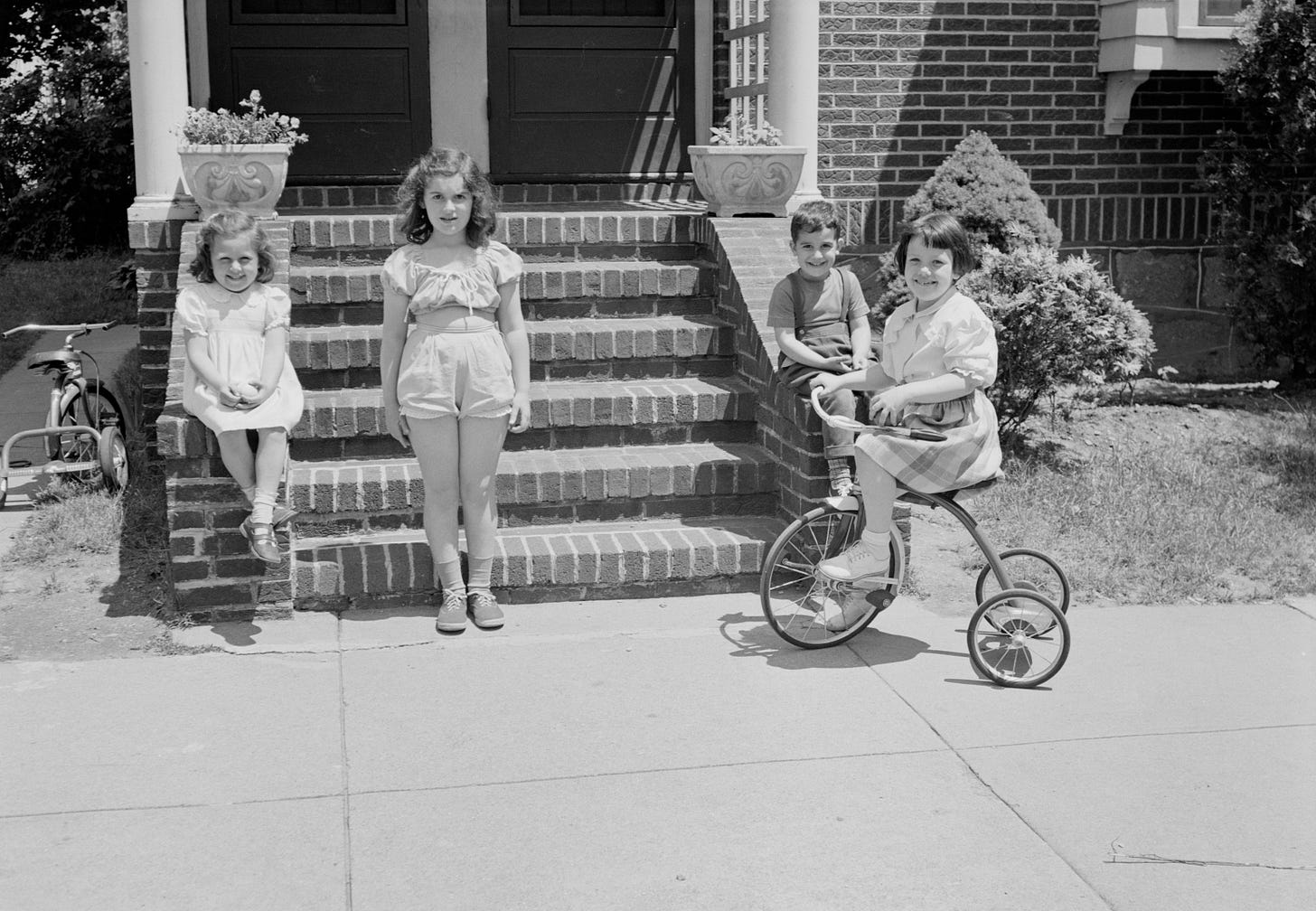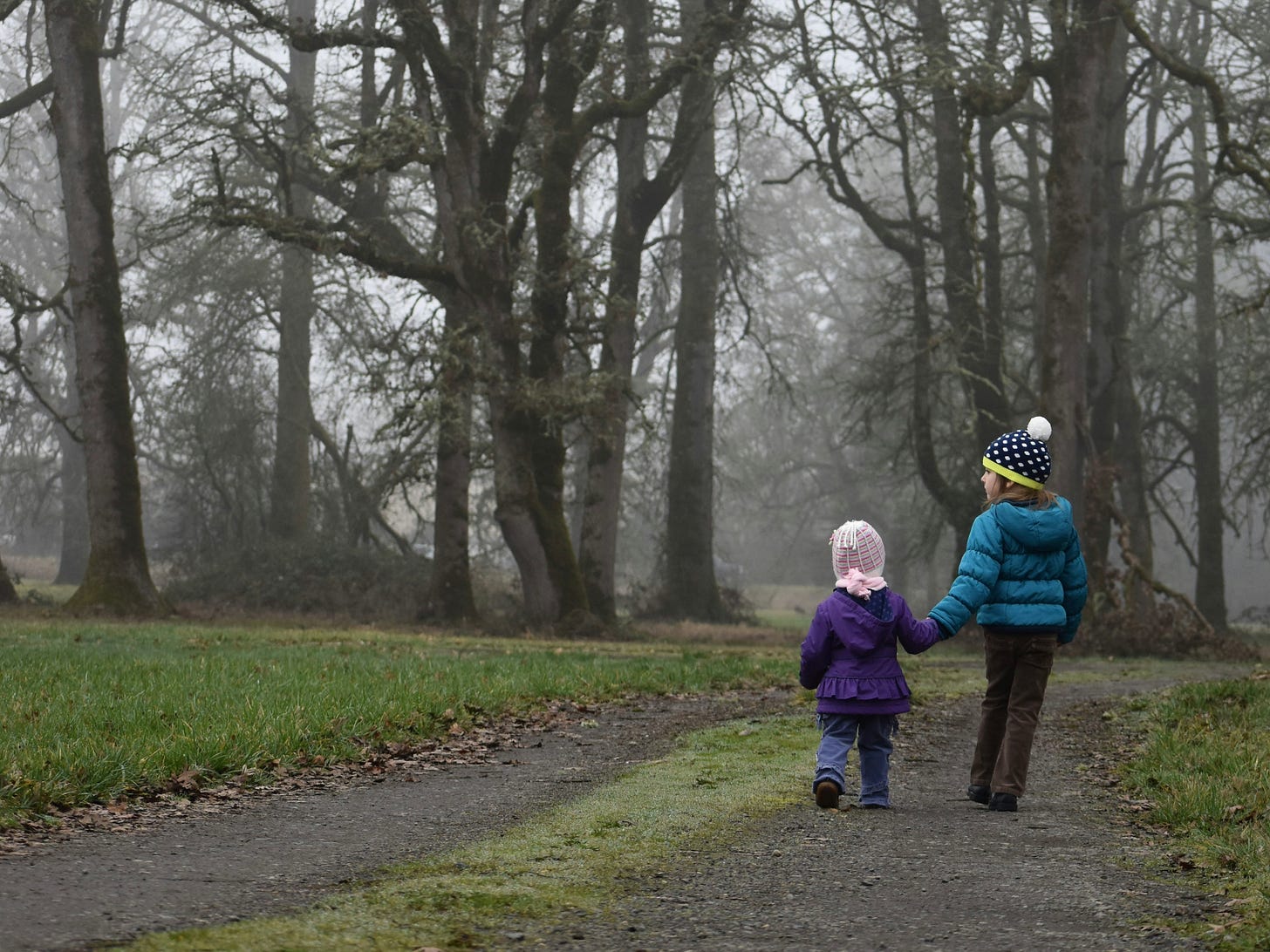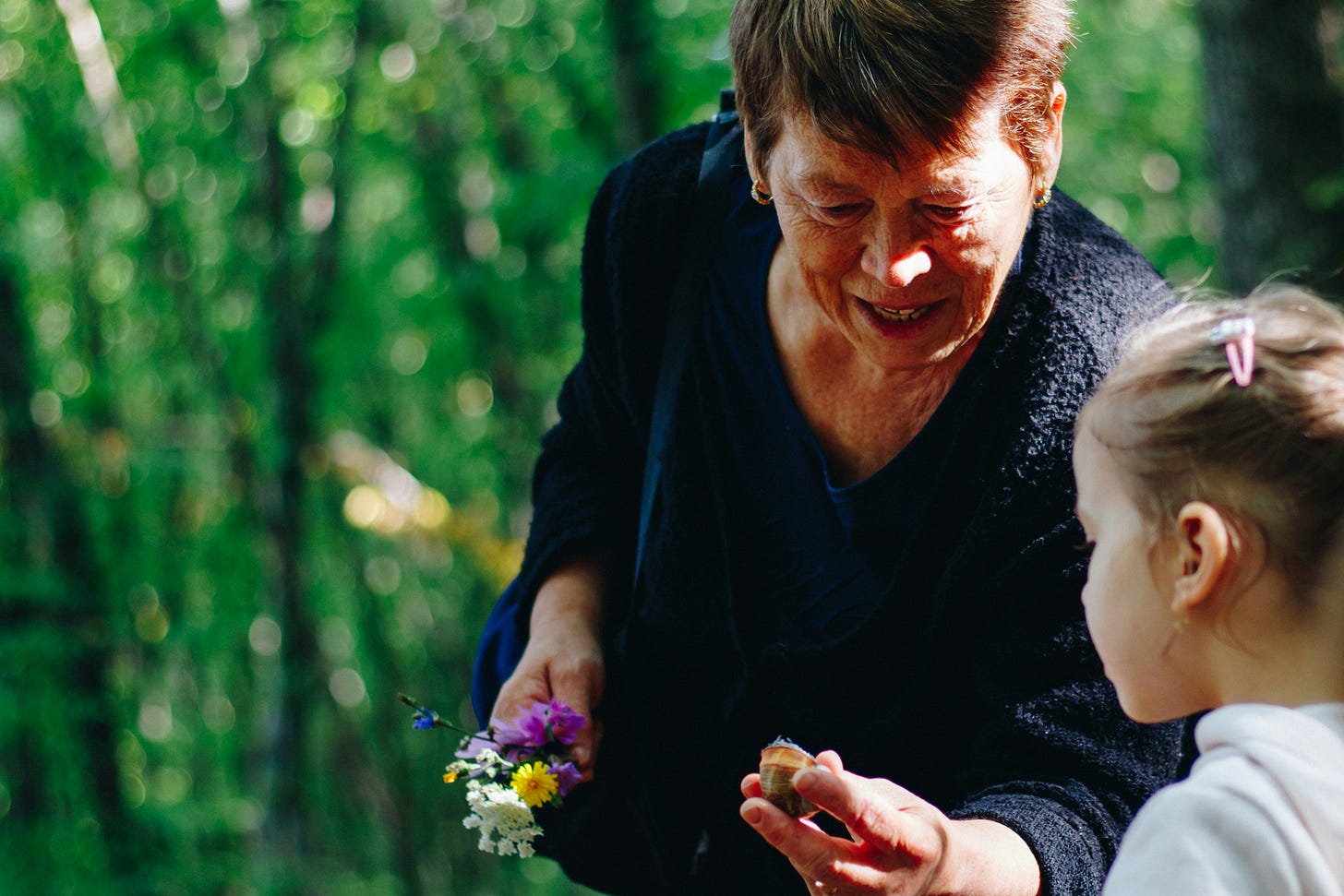Bring Back Neighbourliness
If we want children to play outdoors, we must be good neighbours.
When I was six years old, I asked my mother if I could go on a picnic with my cousin Emily, who was a year older. She agreed, so Emily and I packed a lunch and headed down the winding dirt road to a small gravel pit in the nearby forest. There, we spread our blanket and ate, then frolicked a bit, rolling down the sides of the pit until we felt dizzy.
Not ready to go home, we decided to go visiting. We knocked on neighbours’ doors and were welcomed warmly by the various cottagers who recognized us and seemed amused by our bold sociability. The Thomsons gave us tea and oatmeal cookies. Mrs. Jones offered us homemade fudge. Edith gave us each a granola bar and handed over the next book in The Complete Winnie-the-Pooh collector’s edition set that I borrowed on a weekly basis. Mrs. Halford set out a plate of crackers slathered with peanut butter and glasses of cold milk.
Emily and I were sitting on Mrs. Halford’s deck, our fourth stop, overlooking the lake and reveling in our newfound independence, when the phone rang inside the cottage. It was my mother, asking Mrs. Halford if she had seen us two little girls walking down the road. We were ordered to return home. We dutifully did so, but I still remember feeling regret as I left the half-eaten plate of crackers behind.
My mother met us partway home. She was not upset, but explained that she got worried when we didn’t come home for hours and had begun calling around the lake. “If you change the plan, you need to let me know,” she said. None of my freedom was taken away, and I continued to make social visits (mostly whenever a dessert craving hit). I made a sincere effort to let my mother know where I were going, and she rarely imposed time limits. It felt like a fair arrangement.
Fast forward thirty years, and I now realize that the freedom my mother gave me was greatly enhanced by the neighbours’ participation. Their willingness to welcome me in, offer snacks, indulge in small talk, and then send me on my way enabled the kind of childhood that is now described as “free-range.”
The fact that those neighbours did not chastise my mother for letting me roam or insinuate that I was doing something risky or bothersome meant that I grew up with a sense of comfort and confidence in navigating my neighbourhood. It made me feel like I belonged in that rural lakeside community, and that there was a whole network of wise older adults not only looking out for me, but also invested in my upbringing. It made me more inclined to leave the house.
We Still Need Neighbours
I have been thinking about those neighbours lately. I am now a mother with three school-aged children and, like many other parents at this stage in life, I find myself lamenting the loss of some nebulous quality of life that existed when I was a child but now feels absent.
While some might say it’s mere nostalgia and a natural romanticization of one’s formative early years, I can put my finger on one major factor—the presence of those neighbours and the unwavering awareness I had as a child that kindly adults were always keeping an eye on me, that they understood what an active and curious child needed and were willing to support it. Those neighbours were the embodiment of the metaphorical village that, as the saying goes, is needed to raise a child.
Children have not changed in a single generation. They still need that village for many of the same reasons that I did as a kid in the early nineties—to get out of the house, keep entertained, interact with people other than immediate family, and give parents a break—but I would argue that there are new and even more pressing reasons for needing a village now than 25 years ago. I think that the presence of neighbours and the existence of a friendly, welcoming neighbourhood can counteract the deluge of digital devices that now dominate kids’ lives.
A Drastic Shift
Over the past decade, the way in which children spend their time has changed drastically. According to 2021 data collected by nonprofit organization Common Sense Media, the daily average screen time for 8- to 12-year-olds is 5.5 hours and, for 13- to 18-year-olds, it’s 8 hours, 40 minutes.
It’s not the kids’ fault. The notorious ways in which technology companies design their apps to pull kids in and keep them there has been well documented, as has the harm these programs cause to children’s emotional wellbeing. But the allure of these devices is so great that, as Sapien Labs recently estimated, screen time is displacing up to 2,000 hours a year that would otherwise be spent in face-to-face interactions.
I don’t want to classify all screen time as bad, but these numbers undeniably represent an enormous amount of time not spent doing other important and formative activities that are a crucial part of a well-rounded childhood.
As the author of a book called Childhood Unplugged: Practical Advice to Get Kids Off Screens and Find Balance, I am a staunch proponent of getting kids off devices not only because of the negative implications of excessive screen time (though that is a compelling reason of its own and one that even the U.S. Surgeon General weighed in on last year, citing a “profound risk of harm” from spending too much time on social media), but more because of what stands to be gained by reclaiming childhood as the imaginative, play-filled stage in life that it is meant to be.
Frictionless Entertainment
With smartphones in their pockets and interactive tablets at home, it has become increasingly difficult for children to pull themselves away from online games, videos, and chats. Their focus has shifted away from the outside “real” world that they have historically depended on to learn and engage with others to a virtual one that is endlessly stimulating and highly addictive—and yet, sadly restrictive at the same time.
The virtual world does not hold the same lessons for kids, whether it’s in the development of language skills or empathy, or memory consolidation, or picking up on facial cues, or making eye contact, and the relationships it nurtures are often of lower quality. It’s a pale and cheapened version of the real thing.
Many parents know this already and are eager to curb their kids’ device usage, but they struggle to do it alone. I don’t blame them. It is unrealistic to tell kids to get off their phones without presenting them with alternatives, and there is a limit to the amount of reading, homework, and chores a kid can do to fill those newly free hours. In contemplating this conundrum, I’ve realized that parents should strive to fill that void with outdoor play—and that’s where neighbours, neighbourhoods, and neighbourliness come in.
Send the Kids Outside
I am not suggesting that it is a neighbour’s responsibility to entertain someone else’s child, or even interact with them, but I do believe that being a friendly, engaged neighbour is a critical component of building residential communities that feel welcoming to children. When a child knows that their natural noise and movement are accepted in a neighbourhood, rather than condemned, they will be more inclined to get off their devices and head outdoors to explore and find playmates. And when a parent knows that their child is accepted and valued by the neighbours, they will be more inclined to let them go outside.
Once in the neighbourhood, a child can move their body and get exercise; free play is perfect for banishing the sedentariness that is so often induced by screens. It counteracts the weight gain and underdeveloped gross and fine motor skills that accompany excessive screen use.
A child playing outdoors will get to know “their” territory, which builds confidence in getting around. They will encounter friends and talk to people, which ultimately makes them far safer than knowing no one. They will observe things that pass adults by and become more attuned to seasonal changes.
A child playing outdoors will have opportunities to engage in certain types of risky play, crucial for optimal development; they will test their bodies and their resolve, feel the thrill of near misses, and learn to gauge danger in ways that will serve them well as they grow. This type of play will help them to develop the skills of independence and resilience that they need to be successful in life.
It Starts With You
Perhaps you are reading this and thinking, “That sounds wonderful, but so idealistic. If only my neighbours were that nice!” To that, I say, “It starts with you.” In order to have a warm and welcoming neighbourhood for children, you must be a warm and welcoming neighbour. Fortunately, this is one of those delightfully manageable situations in which you can make the world a better place by starting in your literal backyard.
So, how does one go about fostering neighbourliness and supporting childhood play?
If you are a parent, strive to turn your home into a hub of social activity. Invite other children to play with your kids outside and make a no-devices rule that they will come to appreciate. Fill your yard with loose parts, toys with no defined purpose that can be interpreted in new ways every time, based on the season, a child’s mood, and who their playmates are. Let them play in the way that kids dream of playing—getting dirty and physical, making noise, being wildly creative, uninterrupted by adults for long periods of time.
Send your own kids outside to play daily (this may require de-scheduling their calendar) and talk to other parents in the area about your conscious decision to do so. Encourage them to do the same, and soon your kid might have a regular posse of playmates.
This is not an impossible vision. A brief anecdote:
There was one day last year when my father, visiting from out of town, walked through my backyard and began addressing two kids jumping on our trampoline.
Then he stopped and said, “Hey, you’re not my grandkids!”
The kids didn’t stop jumping, but one shouted from mid-air, “Nope, but we’re their friends!”
My father was delighted by the fact that some neighbourhood children had stopped by, uninvited, for a spontaneous frolic on the trampoline. Shortly after, they took off on their bicycles. This is precisely the kind of free play that kids need more of.
Even if you are not a parent, welcome children into your outdoor space. This isn’t weird or creepy if it’s not fenced off; many parents will be appreciative. Consider telling parents explicitly that it’s OK for their kids to run through the yard and make it part of their expanded territory. My kids’ outdoor play space has quadrupled in size, thanks to next-door neighbours making this generous offer, unprompted. Now their games of manhunt and tag are “epic,” according to them. As a mother, it’s such a relief when neighbours tell me that they enjoy hearing my kids playing outside.
As a neighbour, you might try to engage with the kids who live around you. Say hello, learn their names, establish rapport. Yes, this goes against the “don’t talk to strangers” rule that so many parents robotically repeat to their kids without stopping to realize that it is a supremely dumb piece of advice to dish out. A child should know their neighbours; that’s what makes them feel safe and secure in the world, and it’s quite horrible to teach them the opposite, that everyone’s a potential kidnapper. Instead, trust your child to understand nuance and tell them not to go off with strangers.
Parents may take solace in knowing that their children are safer in a neighbourhood where residents are acquainted with them, attuned to their play routines and presence. Those neighbours are more likely to drive cautiously, to be alert to suspicious activity (in the statistically negligible off-chance that it occurs), and to contact a parent if something seems amiss.
In time, if the parent gives permission, you could invite neighbourhood kids in for visits. My children used to have tea with an elderly woman who lived behind us, and they all loved it. She gave them cookies, they talked about life, and she told me repeatedly how delightful it was to have young visitors to break up an otherwise monotonous day.
That same elderly woman hired them to walk her dog every day, and then two more neighbours did the same. Now my kids have a burgeoning after-school business that not only teaches them responsibility and earns them decent pocket money, but also gets them out of the house each day. As a neighbour, consider offering school-aged kids a job. If you don’t have a dog, what about snow shoveling or leaf raking or helping to carry groceries or put out the recycling? It could be a great opportunity for some cross-generational bonding to occur.
Do You Remember Childhood?
If your own children have grown up and left home, I urge you to remember what it was like both to be a kid and to raise a kid. Think back to what experiences made an impression on you and how children nowadays might benefit from similar experiences. Ask yourself what you can do to foster an environment that’s conducive to free, active outdoor play—and don’t be so quick to judge a parent for doing what appears to be a poor job.
Many neighbours need to stop jumping to conclusions, calling police to report solitary children, accusing parents of neglect without understanding the situation or the child, fueling a culture of fear that is harming children in irreparable ways and making parenting so much more difficult than it already is.
It has always taken a village to raise a child, and it always will. We may have overlooked its value in recent years and allowed it to erode, but if we are serious about curbing kids’ screen time use and getting them back outside, playing and developing in the way they’ve done for millennia, then we need to focus on reconstructing that supportive village once again. I do believe that it could go a long way toward resolving many of the issues our children face today, from loneliness and isolation to addiction, anxiety, lack of focus, and physical inactivity.
Our children would be better off if they had the support of friendly neighbours who made them feel less like inconvenient minors and more like valued, integral members of society. Then they would have purpose, motivation, things to do—and reasons to get off their phones.
You can become that kind of neighbour today.
You Might Also Like:
Cooking Lessons From My Mennonite Grandma
The Art of Family Dinner
When Adults Help Kids
A Note on Subscriptions:
I recently enabled paid subscriptions for The Analog Family. At this point, all content remains free to read and access, but if you enjoy it, please consider upgrading to a paid subscription for only CAD$7/month (the cost of one large fancy latte!) or CAD$70/year. Your support keeps this project growing and thriving and is hugely appreciated!








https://playborhood.com
We live in a neighbourhood of mostly retirees - small three bed semi detached houses adjusting a small wood and a golf course - and worried about our reception when we moved in with a three year old. But everyone seems happy to hear joyful kid noises and will come over for a chat when we are in the front garden. The neighbour’s grandkids will come and hang out and we got a soccer goal from freecycle and leave it accessible, so it’s a lure. And we are going to be noticeable American and get a basketball hoop this summer. We encourage play in the woods, while we are working in the garden.
We cycle to school along a footpath and make sure to say hello to everyone and stop for a chat. Most people, we see every day and I feel like this is an investment in safety, when T is old enough to cycle solo, he’ll have a whole contingent of people who will keep an eye out and help if there were big kids up to mischief or if he fell, etc.